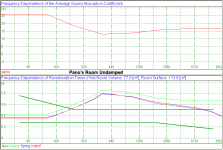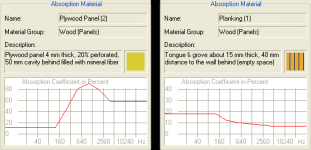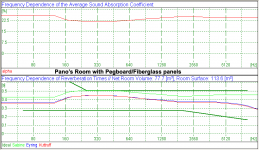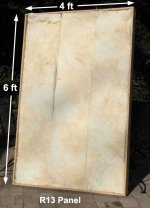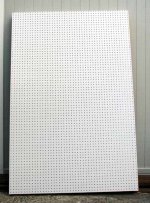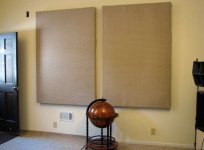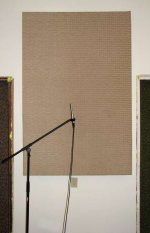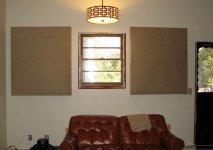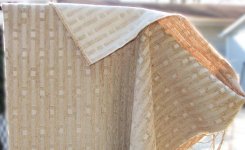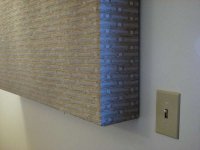Since I need to tame my new Listening Room I've been trying to figure out what to build.
There isn't much info here or elsewhere about the classic pegboard panels, so I thought I might ask if anyone has experience with them.
One of the reasons I ask is because I have the CARA room simulation software. And since I now know exactly the materials and dimensions of my new room, CARA is giving me an accurate model, or so it seems. Below is a graph of what how CARA sees my room acoustics. Very live thru the midrange and even the highs. That's what I hear in the room, the mids ring and the room seems live and bright. I need more mid/high absorption. So what to use?
Looking thru CARA's library of materials leads me to 20% perforated hardboard with mineral wool behind it. This seems to have just the right absorption for my needs. And is basically 1" center pegboard with 1/4" holes. Also seen is a tongue and groove board for comparison.
Has anyone used a pegboard over mineral wool or fiberglass panel like this? Placing a few of these around the room brings me down to almost ideal acoustics, as least as far as absorption, so I'd like to try.
There isn't much info here or elsewhere about the classic pegboard panels, so I thought I might ask if anyone has experience with them.
One of the reasons I ask is because I have the CARA room simulation software. And since I now know exactly the materials and dimensions of my new room, CARA is giving me an accurate model, or so it seems. Below is a graph of what how CARA sees my room acoustics. Very live thru the midrange and even the highs. That's what I hear in the room, the mids ring and the room seems live and bright. I need more mid/high absorption. So what to use?
Looking thru CARA's library of materials leads me to 20% perforated hardboard with mineral wool behind it. This seems to have just the right absorption for my needs. And is basically 1" center pegboard with 1/4" holes. Also seen is a tongue and groove board for comparison.
Has anyone used a pegboard over mineral wool or fiberglass panel like this? Placing a few of these around the room brings me down to almost ideal acoustics, as least as far as absorption, so I'd like to try.
Attachments
Michael
I hope that you aren't forgetting the S.W.M.B.O. factor ?😉
1 metre high 40 or 50mm thick medium density foam works well too, but again , most wives will be most unhappy with anything less than proper commercial type insulation as used in home theatres etc.
Alex
I hope that you aren't forgetting the S.W.M.B.O. factor ?😉
1 metre high 40 or 50mm thick medium density foam works well too, but again , most wives will be most unhappy with anything less than proper commercial type insulation as used in home theatres etc.
Alex
No worries Alex, my wife is not allowed in the listening room!
Anyway, I do plan to make them pretty.
Anyway, I do plan to make them pretty.
Pegboard is a common and effective solution, but it will not works well for early reflection damping.
Congratulations on the new space! It looks great, and having a room you can
configure for an audio room is really worth the effort.
My room is the exact same dimensions, only with 10.5' ceilings. I even have
the decoupled wall and used a solid core door, so I can play plenty loud and
nobody complains.
As a dampening option for behind the speakers, here is what I did. It looks like you may
have enough space for this, and maybe CARA can model the drapes.
I lined the wall behind the speakers with shelves and drapes.
I picked up some discontinued 84"? tall pleated drapes from a jc penny.
Takes some work to get enough, all the same, on sale, that look the way you want.
I split the wall into 3 sections, using a cheap 8' center opening curtain rod
in the center, and fabricated shorter custom lengths out of 1/2" emt for the out
side rods. I built triangular plywood brackets about 16" long to suspend the whole
curtain rod/emt assembly 18" from the wall. I used standard curtain rod hardware on
the end of the plywood brackets to hold both the curtain rod and it also worked
for the emt.
So, behind the curtain I built lots of 15" deep shelves. Mostly short, 24-30" long.
Just cheap metal brackets with plywood shelves with a little trim to make a lip on
the edges. They hold all my spare projects, tubes, cheap used craigslist cd players,
whatever. I also put the TV there, since I hate to look at it when I am listening to music.
It is all out of sight so no fancy woodworking here.
I even balanced the size and placement of the shelves so any reflections are similar,
and cut out the center of the plywood brackets, so they are more invisible to the sound
waves. The wall is about 50 percent covered so lots of breakup of rear waves. And there
are lots of options to put more ugly dampening foam behind the curtain if required.
You can put the speakers right up against the curtain, so I did not loose any useable
space, and gained all the storage and dampening. And all the speakers cables are on the
floor behind the drapes. The room looks better since all that busy clutter is hidden.
The drapes on the side panels just hang on the emt. I still need to put something behind
the couch to breakup that a little bit.
Maybe I'll check out the CARA program. Looks pretty good.
Dave
configure for an audio room is really worth the effort.
My room is the exact same dimensions, only with 10.5' ceilings. I even have
the decoupled wall and used a solid core door, so I can play plenty loud and
nobody complains.
As a dampening option for behind the speakers, here is what I did. It looks like you may
have enough space for this, and maybe CARA can model the drapes.
I lined the wall behind the speakers with shelves and drapes.
I picked up some discontinued 84"? tall pleated drapes from a jc penny.
Takes some work to get enough, all the same, on sale, that look the way you want.
I split the wall into 3 sections, using a cheap 8' center opening curtain rod
in the center, and fabricated shorter custom lengths out of 1/2" emt for the out
side rods. I built triangular plywood brackets about 16" long to suspend the whole
curtain rod/emt assembly 18" from the wall. I used standard curtain rod hardware on
the end of the plywood brackets to hold both the curtain rod and it also worked
for the emt.
So, behind the curtain I built lots of 15" deep shelves. Mostly short, 24-30" long.
Just cheap metal brackets with plywood shelves with a little trim to make a lip on
the edges. They hold all my spare projects, tubes, cheap used craigslist cd players,
whatever. I also put the TV there, since I hate to look at it when I am listening to music.
It is all out of sight so no fancy woodworking here.
I even balanced the size and placement of the shelves so any reflections are similar,
and cut out the center of the plywood brackets, so they are more invisible to the sound
waves. The wall is about 50 percent covered so lots of breakup of rear waves. And there
are lots of options to put more ugly dampening foam behind the curtain if required.
You can put the speakers right up against the curtain, so I did not loose any useable
space, and gained all the storage and dampening. And all the speakers cables are on the
floor behind the drapes. The room looks better since all that busy clutter is hidden.
The drapes on the side panels just hang on the emt. I still need to put something behind
the couch to breakup that a little bit.
Maybe I'll check out the CARA program. Looks pretty good.
Dave
Thanks Dave, cool idea. I had thought about going with shelves full of books behind the speakers. Similar idea. I used to have the whole left wall lined with shelves of random stuff which broke up the reflections very well. So your idea of a random diffuser wall is something I know works well. Just had not thought of hiding it behind a curtain. 
As nac134 notes, the pegboard may not be too good for breaking up reflections. That's my worry. Maybe strips of wood over it to cause some disruption. I've seen a number of DIY acoustic panels around the web, but most are soft panels. That may be what I need to do. Kill some reflections and soak up reverb above 500Hz. I was intrigued by the pegboard/fiberglass panel as being absorptive right were I need it.
CARA is very cool software. The more you put into it, the more you get.

As nac134 notes, the pegboard may not be too good for breaking up reflections. That's my worry. Maybe strips of wood over it to cause some disruption. I've seen a number of DIY acoustic panels around the web, but most are soft panels. That may be what I need to do. Kill some reflections and soak up reverb above 500Hz. I was intrigued by the pegboard/fiberglass panel as being absorptive right were I need it.
CARA is very cool software. The more you put into it, the more you get.
On to building.
OK, I decided to build some of these things. 5 panels are now ready to be loaded with fiberglass and covered with cloth.
There are three 6x4' panels that are 4" deep for R13 insulation, and two that are 4x4' and 6" deep for R30 insulation. It's stuff I had left over from building the listening room.
They are basically just a shallow open face box with a pegboard back. I went to a large surplus fabric store and was overwhelmed with choices of cloth to cover these with. The plan was for good old burlap at $2-$3 a yard, but I found some nice upholstery fabric on sale for $7 a yard. Nice looking, thick, strong. Would normally sell for about $20 a yard or more. I'm hoping that it damps well, like heavy curtains.
Funny thing is, just getting the panels built and stacked in the room is already an acoustic improvement. No fiberglass yet, so it promises to work well.
I plan to mount them soft side out. But can always flip them for pegboard out if that sounds better.
There is pegboard left over so I may build a few more small panels for the ceiling or something. Also bought thin ply to build a diffuser behind the speakers.
Yes, I'll post photos. 🙂
OK, I decided to build some of these things. 5 panels are now ready to be loaded with fiberglass and covered with cloth.
There are three 6x4' panels that are 4" deep for R13 insulation, and two that are 4x4' and 6" deep for R30 insulation. It's stuff I had left over from building the listening room.
They are basically just a shallow open face box with a pegboard back. I went to a large surplus fabric store and was overwhelmed with choices of cloth to cover these with. The plan was for good old burlap at $2-$3 a yard, but I found some nice upholstery fabric on sale for $7 a yard. Nice looking, thick, strong. Would normally sell for about $20 a yard or more. I'm hoping that it damps well, like heavy curtains.
Funny thing is, just getting the panels built and stacked in the room is already an acoustic improvement. No fiberglass yet, so it promises to work well.
I plan to mount them soft side out. But can always flip them for pegboard out if that sounds better.
There is pegboard left over so I may build a few more small panels for the ceiling or something. Also bought thin ply to build a diffuser behind the speakers.
Yes, I'll post photos. 🙂
Just a teaser.
The panels work very well indeed. Below is a graph of the room T30 reverberation before and after the panels. Mic in exactly the same spot. Both speakers playing.
As you can see, the hot frequencies have their reverb time cut almost in half and the curve is much flatter. That's what the CARA software predicts. However CARA predicted the peak about 1 octave low.
This is a huge improvement. The sound is much cleaner and smoother now. The "Ping!" is gone. I will post photos of the panels and their construction tomorrow.
The panels work very well indeed. Below is a graph of the room T30 reverberation before and after the panels. Mic in exactly the same spot. Both speakers playing.
As you can see, the hot frequencies have their reverb time cut almost in half and the curve is much flatter. That's what the CARA software predicts. However CARA predicted the peak about 1 octave low.
This is a huge improvement. The sound is much cleaner and smoother now. The "Ping!" is gone. I will post photos of the panels and their construction tomorrow.
Attachments
Some photos of the insides of the panels.
Rather crude, but is now covered by cloth.
The back is pegboard, the sides are 1/2" plywood. The insides are filled with normal household fiberglass insulation. All held together with brads (air gun) and glue. The fiberglass is held in place with a coat of glue on the pegboard. That should keep it from sagging. So far, so good.
I'll take some photos of them on the wall today.
Rather crude, but is now covered by cloth.
The back is pegboard, the sides are 1/2" plywood. The insides are filled with normal household fiberglass insulation. All held together with brads (air gun) and glue. The fiberglass is held in place with a coat of glue on the pegboard. That should keep it from sagging. So far, so good.
I'll take some photos of them on the wall today.
Attachments
Do you have a worry about breathing micro bits of fiber, since the cloth covering has to be porous?
What's the space between pegboard and wall?
What's the space between pegboard and wall?
The idea behind the panels.
These panels were built to help the much too live acoustics in my new listening room. The walls are mostly blank drywall (gypsum board) and a flat plywood ceiling. The floor is a concrete slab covered by heavy carpet and carpet pad.
Needless to say, the room had acoustic problems. A lot of slap echo from the large parallel walls and a distinct midrange PING! from all the reflective surfaces. Very much what you would expect in a room like this. The tall ceiling was its only saving grace.
I knew the room would need panels, but what kind? I've seen and heard a lot of acoustic panels over the years, but never built any. Of course like so many DIY projects, this one began with a Google search. There aren't many diy panels out there, but those that are look a lot like what I built. No surprise, they are not expensive, not hard to build and work very well. Excellent for DIY.
The pegboard thing intrigued me because I had seen it in so many old control booths and recording spaces with pegboard over "something" as acoustic treatment. Looking at the limited data on the pegboard, it seems to have peak absorption in the midrange - perhaps it's the holes and their spacing. Exactly what I needed. Although, as you might be able to tell from looking at it, there isn't much absorption in the higher octaves. The thicker the layer of fiberglass behind the pegboard, the lower in frequency the absorption extends, tho the midrange peak stays.
So I built these with the pegboard backs and soft fronts thinking that they could be turned around if needed. So far, using a soft, cloth covered front and the pegboard on the back has worked out very well.
Next: How to build them and the mistakes to avoid.
These panels were built to help the much too live acoustics in my new listening room. The walls are mostly blank drywall (gypsum board) and a flat plywood ceiling. The floor is a concrete slab covered by heavy carpet and carpet pad.
Needless to say, the room had acoustic problems. A lot of slap echo from the large parallel walls and a distinct midrange PING! from all the reflective surfaces. Very much what you would expect in a room like this. The tall ceiling was its only saving grace.
I knew the room would need panels, but what kind? I've seen and heard a lot of acoustic panels over the years, but never built any. Of course like so many DIY projects, this one began with a Google search. There aren't many diy panels out there, but those that are look a lot like what I built. No surprise, they are not expensive, not hard to build and work very well. Excellent for DIY.
The pegboard thing intrigued me because I had seen it in so many old control booths and recording spaces with pegboard over "something" as acoustic treatment. Looking at the limited data on the pegboard, it seems to have peak absorption in the midrange - perhaps it's the holes and their spacing. Exactly what I needed. Although, as you might be able to tell from looking at it, there isn't much absorption in the higher octaves. The thicker the layer of fiberglass behind the pegboard, the lower in frequency the absorption extends, tho the midrange peak stays.
So I built these with the pegboard backs and soft fronts thinking that they could be turned around if needed. So far, using a soft, cloth covered front and the pegboard on the back has worked out very well.
Next: How to build them and the mistakes to avoid.
Do you have a worry about breathing micro bits of fiber, since the cloth covering has to be porous?
Maybe. But I used a thick upholstery fabric which does not seem to let any fibers thru. (photos coming). The thicker fabric seems to be no impediment to the mids and lows, and may absorb a lot of highs before they ever get to the fiberglass. Originally I wanted to used the Bonded Logic "Ultra Touch" cotton insulation, but could not get it locally. If you can find it, I recommend it. Some of the projects online use a layer of poly batting over the fiberglass. That should also help.
Good question!What's the space between pegboard and wall?
At the moment, basically nil. So I doubt the holes in the pegboard are having any effect. I do plan to try some spacers behind the panels to see if it makes any difference.
I do plan to try some spacers behind the panels to see if it makes any difference.
My magic 8-ball says it will. Try a few inches from the wall.
I'd love to be doing a project like this, but until I have my own room, well... you've met my wife. For my own experimentation, I'd want to make the pegboard holes quite a bit bigger and vary the spacing. Weeks of fun, and with something that absolutely and incontrovertibly does make a big difference in sound.
PPG has beat you to it. At least in the variation of position.
RPG Diffusor Systems
I'd love to have these, but they are $$$.
As I have some smaller pegboard panels left, I may hang them from the ceiling in an attempt to bring midrange reflection times down to 0.4 seconds (T30)
Wives are lovely things, but often an impediment to good sound.
RPG Diffusor Systems
I'd love to have these, but they are $$$.
As I have some smaller pegboard panels left, I may hang them from the ceiling in an attempt to bring midrange reflection times down to 0.4 seconds (T30)
Wives are lovely things, but often an impediment to good sound.
Some photos
Here are the panels in action.
As you can see, the room is still pretty bare and needs finishing, but it sounds good. The panels look a little better than in my photos, but they are certainly not a slick, factory made item. And they are heavy! The tall ones weigh in at almost 40 pounds (18Kg).
Also pictured is the cloth used to cover them.
One mistake I made was to build the 6x4 panels too wide. Could not wrap the fabric around the back on both sides. Remember that!
Here are the panels in action.
As you can see, the room is still pretty bare and needs finishing, but it sounds good. The panels look a little better than in my photos, but they are certainly not a slick, factory made item. And they are heavy! The tall ones weigh in at almost 40 pounds (18Kg).
Also pictured is the cloth used to cover them.
One mistake I made was to build the 6x4 panels too wide. Could not wrap the fabric around the back on both sides. Remember that!
Attachments
I'd be curious to see you try spinning them around and measuring to see if it is closer to the CARA predictions. I always thought pegboard was used in the front to minimize HF absorption. Distance from the wall should affect LF substantially.
A good idea Ron, and the original plan. Turn them one way or the other depending on acoustic need. Didn't work out that way, tho. The are so big and clumsy that once on the wall, I'm leaving them!
However, I may been lucky. They seem to do exactly what I need. CARA was wrong about the peak reverberation frequency, but it was very close on the before and after T30 times.
However, I may been lucky. They seem to do exactly what I need. CARA was wrong about the peak reverberation frequency, but it was very close on the before and after T30 times.
Looks good Pano.
You've probably seen it but Ethan Winer has lots of good info HERE.
I do a lot of commercial construction, schools, etc and there is a product that is used extensively in gyms and music rooms: Tectum panels. Often used to treat the top 1/3 of a gyms walls or replaces the standard ceiling tiles in a drop ceiling for a music room. Based on the differences that I've heard, I think that these are probably very effective. I'm not sure how much they cost though.
You've probably seen it but Ethan Winer has lots of good info HERE.
I do a lot of commercial construction, schools, etc and there is a product that is used extensively in gyms and music rooms: Tectum panels. Often used to treat the top 1/3 of a gyms walls or replaces the standard ceiling tiles in a drop ceiling for a music room. Based on the differences that I've heard, I think that these are probably very effective. I'm not sure how much they cost though.
Hey John, thanks!
I don't think I've met Ethan, but have seen and heard his Real Traps often. Good stuff. His website has a lot of useful info, for sure.
Great link on the Tectum panels. When I think acoustic panels, that is exactly what comes to mind. Maybe because I've seen them so often and for so long. Had no idea what they were called. Their PDFs have some useful info. I'm going to look into these.
I don't think I've met Ethan, but have seen and heard his Real Traps often. Good stuff. His website has a lot of useful info, for sure.
Great link on the Tectum panels. When I think acoustic panels, that is exactly what comes to mind. Maybe because I've seen them so often and for so long. Had no idea what they were called. Their PDFs have some useful info. I'm going to look into these.
Hey Pano, I favor covering more of the wall, lower and higher... making the reflective surfaces more uniform, without a "hard" transition as there is behind your listening chairs...
_-_-bear
_-_-bear
- Status
- Not open for further replies.
- Home
- General Interest
- Room Acoustics & Mods
- Making Pegboard Acoustic Panels
